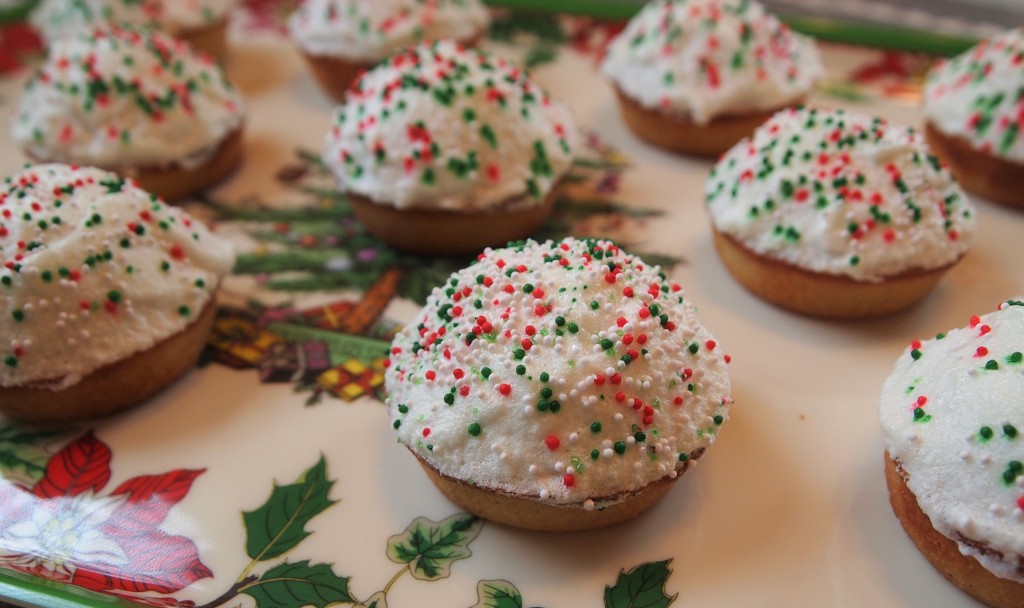Queen cakes, popular in the 18th and 19th centuries, were little cakes usually baked in fancy molds. I was drawn to this particular recipe, from Eliza Leslie’s 1828 book Seventy-Five Receipts for Pastry, Cakes, and Sweetmeats, because it seemed especially fancy. Although queen cakes could be made any time of year, Leslie suggests decorating these with red and green nonpareils, which made me think they would be perfect for Christmas.

Queen Cakes (makes 16):
- 1/2 pound baker’s sugar
- 1/2 pound butter
- 7 oz sifted flour
- 4 eggs
- 1 tbsp white wine
- 1 tbsp brandy
- 1 tbsp rose water, or 6 drops of lemon extract
- 1/4 tsp mace
- 1/4 tsp cinnamon
- half a nutmeg, grated
- Cream together the butter and sugar.
- Beat the eggs in a separate bowl until they are smooth and thick.
- Add the eggs and flour alternately to the creamed butter and sugar.
- Add the spices, wine, brandy, and rose water or lemon extract. Beat mixture thoroughly for another minute.
- Spoon the batter into greased muffin tins, filling each about 3/4 full. Bake at 350 degrees for about 15-17 minutes, until the edges turn golden brown and start to shrink away from the sides of the pan.
- Once the cakes have cooled, cover them with icing (see below) and decorate with red and green nonpareils.
I messed up Eliza Leslie’s given icing recipe (3 egg whites to 24 teaspoons of sugar, plus a tsp of rose water or 8 drops of lemon extract) by accidentally putting in the full amount of egg whites, but only half the sugar. I didn’t realize my mistake until the icing was on the cakes – even after attempting to dry it out in the oven for a long time, the topping remained very sticky and eggy. It’s definitely supposed to be a stiff meringue instead, probably more like the meringue I made earlier for Snow Balls, another 1820s recipe. If you don’t like meringue, royal icing would also be a period-appropriate topping.

Tasting notes:
Although I was disappointed with my meringue mistake, the cakes themselves were good little pound cakes. I could definitely taste the nutmeg and the brandy. The other flavors, however (cinnamon, rose water, and wine) were a bit muted. Using rose water AND brandy AND wine seems like too much; I would just pick one flavor and stick to it. I didn’t try flavoring them with lemon extract, but I think that would be good as well. The cakes are best fresh; the next day they do start to feel heavier. That being said, they still disappeared fairly quickly!

References:
Leslie, E. (1828). Seventy-five receipts for pastry, cakes, and sweetmeats. Boston: Monroe and Francis. https://play.google.com/books/reader?id=3LdcrRLu6ZMC&hl=en&pg=GBS.PA47
Mason, L. (2006). Queen cake. In A. Davidson & T. Jaine (Eds.), The Oxford companion to food (p. 645). Oxford: Oxford University Press.


They look so sweet!
LikeLike
[…] 18th century heart cakes are a variation on queen cakes, which were also often baked in heart-shaped tins. This recipe, from Charlotte Mason’s 1777 […]
LikeLike
Oh my gosh, where has your blog been all my life? I stumbled upon while looking for this recipe, which I saw on the YouTube channel “Early American.” But I didn’t want to make enough to feed the entire planet, so I’m glad I came across this. Thank you!
LikeLike
Haha, making enough to feed the planet is a perpetual problem with historical recipes.
LikeLike